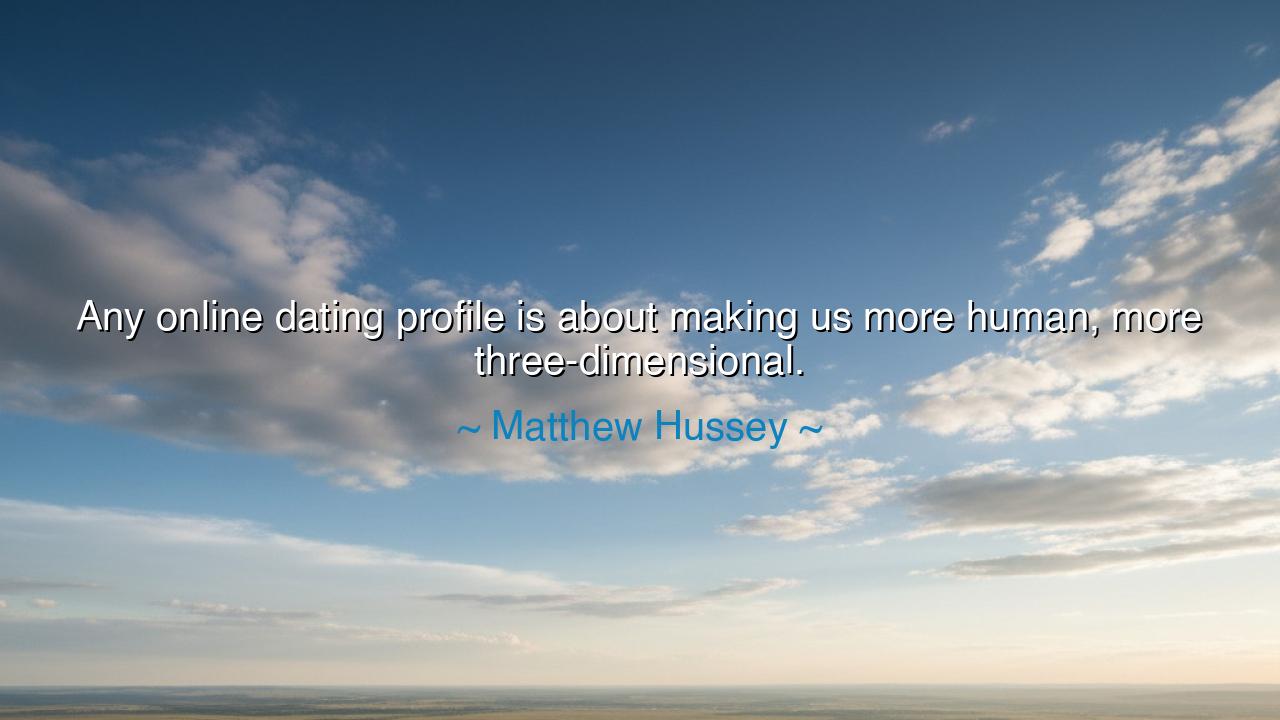
Any online dating profile is about making us more human, more






The words of Matthew Hussey — “Any online dating profile is about making us more human, more three-dimensional.” — are a reflection on the paradox of modern love: that even within the digital realm, where pixels replace presence and screens mediate emotion, the truest task of connection remains the same — to be fully human. In this statement lies both insight and challenge. It is not a lesson about technology, but about authenticity — about how, in a world of filtered faces and curated words, the greatest act of courage is to reveal oneself wholly, without illusion. Hussey reminds us that behind every profile, every message, every first impression, there still beats a heart that longs to be known.
In his words, we find the echo of an ancient truth dressed in modern form: that love has always been the art of revelation. Whether by candlelight or phone screen, the human longing remains the same — to be seen not as a collection of attributes, but as a soul. When Hussey speaks of becoming “more three-dimensional,” he points to the essence of intimacy itself: the act of moving from surface to depth, from appearance to reality. The ancients understood this too. When the Greek philosopher Plato wrote of love in the Symposium, he described it as a journey from the beautiful body to the beautiful soul — a movement from image to essence. In that way, Hussey’s reflection is not new; it is the timeless call to peel back the layers of performance and allow our true selves to breathe.
The origin of such wisdom comes from observing how modern life tempts us into artifice. The online world — radiant, fast, and ever-changing — invites us to present perfected versions of ourselves: the smile without the story, the success without the struggle. Yet what Hussey reminds us is that connection cannot thrive on perfection; it thrives on vulnerability. To be “three-dimensional” is to show not only our triumphs but our tender edges — the fears, quirks, and contradictions that make us real. For love is not the meeting of ideals, but the meeting of truths. When two people encounter one another in honesty, they step beyond the flatness of pretense and into the fullness of human experience.
History gives us many examples of this truth. Consider the letters between Abelard and Héloïse, two lovers separated by circumstance yet bound by their words. In their letters, they bared their minds and souls without veil or polish. Abelard spoke of his shame and devotion; Héloïse confessed her doubts and longing. Their writings, though centuries old, possess more humanity than a thousand digital profiles today, for they dared to show the whole of themselves — not only who they were, but who they struggled to become. Their love endured not because of perfection, but because of depth. So too does Hussey’s wisdom challenge us to bring such depth into our digital age — to use technology not as a mask, but as a mirror that reflects truth.
Yet to do this requires courage, for to reveal oneself is to risk rejection. It is easier to remain two-dimensional, to display only the angles that win admiration. But the ancients would have said that no great love can be built upon fear. The poet Rumi wrote, “The wound is where the light enters you.” In this, he meant that love begins where we dare to be vulnerable — where we show the parts of ourselves that ache, that hope, that still tremble with uncertainty. In an age where connection is instantaneous but intimacy is rare, Hussey’s call to “be more human” is an invitation to rediscover the sacred art of being real.
There is also wisdom here about how we see others. Just as we wish to be seen in our fullness, we must also learn to look deeply. The flattened world of profiles and pictures teaches us to judge quickly, to swipe past souls as if they were objects. But the wise heart pauses. It listens for the music beneath the surface — the laughter, the struggle, the story. For to truly know another is to see their humanity, not their highlight reel. Hussey’s words remind us that compassion is the highest form of perception; only by recognizing another’s complexity can we begin to love them honestly.
The lesson we can draw from this is clear: to connect in truth, whether online or in person, is to embrace wholeness. When you write about yourself — in words, in gestures, or in the silent story of your life — let it be real. Speak of what you love, but also of what you’ve learned. Show not only who you wish to be, but who you are when no one watches. Resist the temptation to be perfect; instead, be whole. For love cannot grow in shadow — it requires the light of authenticity to bloom.
And so, let us take to heart the wisdom of Matthew Hussey: that even in this modern, digitized world, the sacred work of love remains ancient — to reveal, to understand, to see, and to be seen. Every word we write, every story we tell, should strive toward humanity, not performance. For the heart that dares to show itself fully is the heart that will one day be met, not with illusion, but with truth — and in that truth, find the connection that no algorithm can create.






AAdministratorAdministrator
Welcome, honored guests. Please leave a comment, we will respond soon